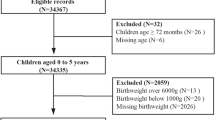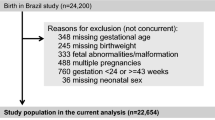Abstract
Objective:
To assess risk factors for macrosomic infant birth among Latina women.
Study Design:
Prospective study of Latina women recruited during pregnancy from prenatal clinic at San Francisco General Hospital. Information was obtained through a structured interview and review of medical records.
Result:
A total of 11% of women delivered macrosomic infants (birth weight >4000 g). In unadjusted analyses, significant risk factors for macrosomia included older maternal age, increasing gravidity, previous history of macrosomic birth and pre-pregnancy overweight. After adjusting for confounders using multivariate analyses, older mothers (10-year increments) had an elevated risk of macrosomia (odds ratio (OR) 2.59; 95% confidence interval (CI) 1.28 to 5.24).
Conclusion:
Efforts to reduce macrosomia in Latina women should focus on older mothers.
This is a preview of subscription content, access via your institution
Access options
Subscribe to this journal
Receive 12 print issues and online access
$259.00 per year
only $21.58 per issue
Buy this article
- Purchase on Springer Link
- Instant access to full article PDF
Prices may be subject to local taxes which are calculated during checkout
Similar content being viewed by others
References
Centers for Disease Control and Prevention (CDC). Births: final data for 2004. Natl Vital Stat Rep 2006; 55 (1): 1–102.
Diani F, Venanzi S, Zanconato G, Murari S, Moscatelli C, Turinetto A . Fetal macrosomia and management of delivery. Clin Exp Obstet Gynecol 1997; 24 (4): 212–214.
Mei Z, Grummer-Strawn LM, Scanlon KS . Does overweight in infancy persist through the preschool years? An analysis of CDC Pediatric Nutrition Surveillance System data. Soz Praventivmed 2003; 48 (3): 161–167.
Curhan GC, Chertow GM, Willett WC, Spiegelman D, Colditz GA, Manson JE et al. Birth weight and adult hypertension and obesity in women. Circulation 1996; 94 (6): 1310–1315.
Seidman DS, Laor A, Gale R, Stevenson DK, Dannon YL . A longitudinal study of birth weight and being overweight in late adolescence. Am J Dis Child 1991; 145 (7): 782–785.
Rasmussen F, Johansson M . The relation of weight, length and ponderal index at birth to body mass index and overweight among 18-year-old males in Sweden. Eur J Epidemiol 1998; 14 (4): 373–380.
Cohn GS, Kittleson MM, Blumenthal RS . Toward an improved diagnosis of the metabolic syndrome other clues to the presence of insulin resistance. Am J Hypertens 2005; 18 (8): 1099–1103.
Burke V . Obesity in childhood and cardiovascular risk. Clin Exp Pharmacol Physiol 2006; 33 (9): 831–837.
Jolly MC, Sebire NJ, Harris JP, Regan L, Robinson S . Risk factors for macrosomia and its clinical consequences: a study of 350 311 pregnancies. Eur J Obstet Gynecol Reprod Biol 2003; 111 (1): 9–14.
Stotland NE, Hopkins LM, Caughey AB . Gestational weight gain, macrosomia, and risk of cesarean birth in nondiabetic nulliparas. Obstet Gynecol 2004; 104 (4): 671–677.
Mathew M, Machado L, Al-Ghabshi R, Al-Haddabi R . Fetal macrosomia. Risk factor and outcome. Saudi Med J 2005; 26 (1): 96–100.
Ehrenberg HM, Mercer BM, Catalano PM . The influence of obesity and diabetes on the prevalence of macrosomia. Am J Obstet Gynecol 2004; 191 (3): 964–968.
Boulet SL, Alexander GR, Salihu HM, Pass M . Macrosomic births in the United States: determinants, outcomes, and proposed grades of risk. Am J Obstet Gynecol 2003; 188 (5): 1372–1378.
Orskou J, Henriksen TB, Kesmodel U, Secher NJ . Maternal characteristics and lifestyle factors and the risk of delivering high birth weight infants. Obstet Gynecol 2003; 102 (1): 115–120.
Deruelle P, Houfflin-Debarge V, Vaast P, Delville N, Helou N, Subtil D . Maternal and fetal consequences of increased gestational weight gain in women of normal prepregnant weight. Gynecol Obstet Fertil 2004; 32 (5): 398–403.
Hardy DS . A multiethnic study of the predictors of macrosomia. Diabetes Educ 1999; 25 (6): 925–932.
Homko CJ, Sivan E, Nyirjesy P, Reece EA . The interrelationship between ethnicity and gestational diabetes in fetal macrosomia. Diabetes Care 1995; 18 (11): 1442–1445.
Steinfeld JD, Valentine S, Lerer T, Ingardia CJ, Wax JR, Curry SL . Obesity-related complications of pregnancy vary by race. J Matern Fetal Med 2000; 9 (4): 238–241.
Cleary-Goldman J, Malone FD, Vidaver J, Ball RH, Nyberg DA, Comstock CH et al. Impact of maternal age on obstetric outcome. Obstet Gynecol 2005; 105 (5 Part 1): 983–990.
Hessol NA, Missett B, Fuentes-Afflick E . Lower agreement on behavioral factors than on medical conditions in self-reported data among pregnant Latina women. Arch Med Res 2004; 35: 241–245.
Center for Disease Control (CDC). Overweight and Obesity: Defining Overweight and Obesity: http://www.cdc.gov/nccdphp/dnpa/obesity/defining.htm, accessed November 20, 2006.
American College of Obstetricians and Gynecologists (ACOG). Fetal Macrosomia. American College of Obstetricians and Gynecologists (ACOG): Washington, DC, 2000 Nov. 11 p. (ACOG practice bulletin; no. 22).
Block G, Gillespie C, Rosenbaum EH, Jenson C . A rapid food screener to assess fat and fruit vegetable intake. Am J Prev Med 2000; 18 (4): 284–288.
Kasirye OC, Walsh JA, Romaro PS, Beckett LA, Garcia JA, Elvine-Kreis B et al. Acculturation and its association with health-risk behaviors in a rural Latina population. Ethnic Dis 2005; 15 (4): 733–739.
Schaffer DM, Velie EM, Shaw GM, Todoroff KP . Energy and nutrient intakes and health practices of Latinas and white non-Latinas in the 3 months before pregnancy. J Am Diet Assoc 1998; 98 (8): 876–884.
Harley K, Eskenazi B, Block G . The association of time in the US and diet during pregnancy in low-income women of Mexican descent. Paediatr Perinat Epidemiol 2005; 19 (2): 125–134.
Balcazar H, Cole G, Hartner J . Mexican-Americans' use of prenatal care and its relationship to maternal risk factors and pregnancy outcomes. Am J Prev Med 1992; 8 (1): 1–7.
Balcazar H, Hartner J, Cole G . The effects of prenatal care utilization and maternal risk factors on pregnancy outcomes between Mexican Americans and non-Hispanic whites. J Natl Med Assoc 1993; 85 (3): 195–202.
Rosenberg TJ, Garbers S, Chavkin W, Chiasson MA . Prepregnancy weight and adverse perinatal outcomes in an ethnically diverse population. Obstet Gynecol 2003; 102 (5 Pt 1): 1022–1027.
Leipold H, Worda C, Gruber CJ, Kautzky-Willer A, Husslein PW, Bancher-Todesca D . Large-for-gestational-age newborns in women with insulin-treated gestational diabetes under strict metabolic control. Wien Klin Wochenschr 2005; 117 (15–16): 521–525.
Romon M, Nuttens MS, Vambergue A, Verier-Mine O, Biausque S, Lemaire C et al. Higher carbohydrate intake is associated with decreased incidence of newborn macrosomia in women with gestational diabetes. J Am Diet Assoc 2001; 101 (8): 897–902.
Lee BE, Hong YC, Lee KH, Kim YJ, Kim WK, Chang NS et al. Influence of maternal serum levels of vitamins C and E during the second trimester on birth weight and length. Eur J Clin Nutr 2004; 58 (10): 1365–1371.
Gregory-Mercado KY, Staten LK, Ranger-Moore J, Thomson CA, Will JC, Ford ES et al. Fruit and vegetable consumption of older Mexican-American women is associated with their acculturation level. Ethnic Dis 2006; 16 (1): 89–95.
Siega-Riz AM, Hartzema AG, Turnbull C, Thorp J, McDonald T, Cogswell ME . The effects of prophylactic iron given in prenatal supplements on iron status and birth outcomes: a randomized controlled trial. Am J Obstet Gynecol 2006; 194 (2): 512–519.
Schulze MB, Manson JE, Ludwig DS, Colditz GA, Stampfer MJ, Willett WC et al. Sugar-sweetened beverages, weight gain, and incidence of type 2 diabetes in young and middle-aged women. JAMA 2004; 292 (8): 927–934.
Acknowledgements
This study was supported by grants to Dr Fuentes-Afflick from the National Center for Research Resources through a Minority Clinical Associate Physician award (3 M01 RR0083-34S1), a Generalist Physician Faculty Scholar Award from the Robert Wood Johnson Foundation and the National Institutes for Child Health and Human Development (HD 01303). The study interviews were conducted in the General Clinical Research Center at San Francisco General Hospital and were partially supported by grant M01 RR00083-41. Dr Heyman is supported by NIH grant DK 060617.
Author information
Authors and Affiliations
Corresponding author
Rights and permissions
About this article
Cite this article
Wojcicki, J., Hessol, N., Heyman, M. et al. Risk factors for macrosomia in infants born to Latina women. J Perinatol 28, 743–749 (2008). https://doi.org/10.1038/jp.2008.94
Received:
Revised:
Accepted:
Published:
Issue Date:
DOI: https://doi.org/10.1038/jp.2008.94
Keywords
This article is cited by
-
Spatial quantile regression with application to high and low child birth weight in Malawi
BMC Public Health (2019)



